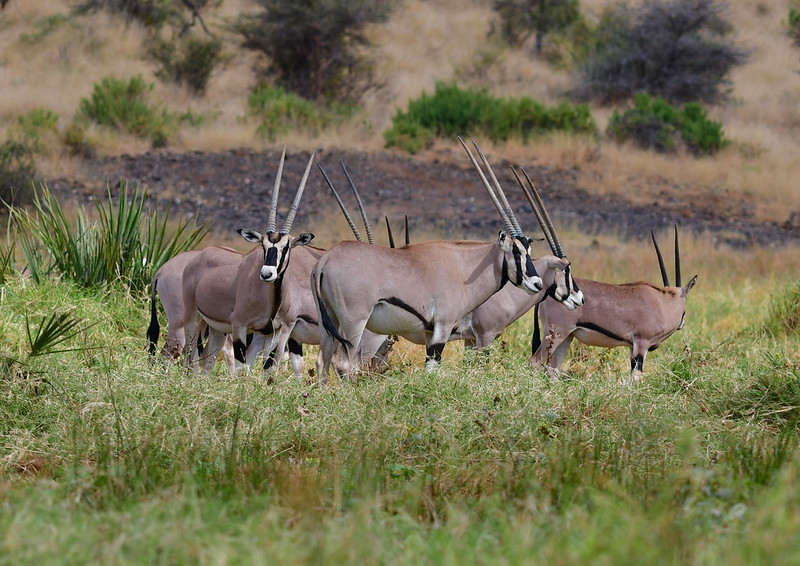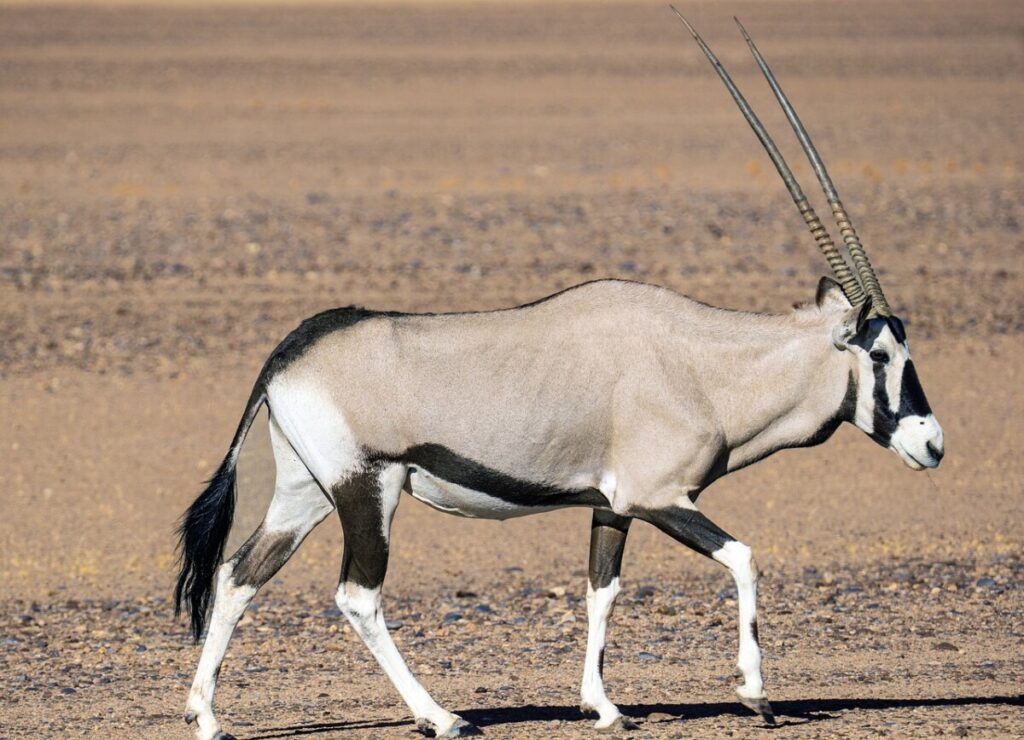The oryx, also known as the gemsbok, is a large antelope found in deserts and arid regions throughout Africa. Their striking appearance and unique behavior make them an interesting species to observe and study.
This article examines what predators hunt the oryx to survive in these harsh conditions. It will provide information on the various animals that prey upon this majestic creature and discuss how they operate within the food chain of desert ecosystems.
Additionally, it will explore possible explanations for why some parts of the population may have fewer natural predators than others. By delving into this topic, readers can gain further insight into the fascinating life cycle of one of Africa’s most iconic creatures.

What Is An Oryx
An oryx is a species of large antelope belonging to the genus Oryx. It inhabits dry regions in Africa and Asia, including deserts, steppes, grasslands, and savannas. Oryx typically weigh between 270-400 pounds, with males slightly heavier than females. They are distinguished by their long necks, white bellies, and black legs. Their horns vary based on gender; adult males have larger horns than females.
Oryx predators include lions, cheetahs, leopards, hyenas, and wild dogs. In addition to these large carnivores, they may also be hunted by humans for sport or as part of subsistence hunting activities. To defend themselves against predators, they form herds cooperating when threatened.
The herd members take turns standing guard while others feed or rest to provide better protection from potential threats. Additionally, the sharp horns possessed by both male and female Oryx can serve as an effective deterrent against some predators, such as hyenas or wild dogs.
In light of this information, it is clear that Oryx face multiple threats from various sources throughout their range—predators old and new must be considered when examining how best to protect this iconic species from extinction due to human encroachment upon its habitat and unsustainable hunting practices.
Predators Of Arabian Oryx
The Arabian oryx (Oryx leucoryx) is a species of antelope native to the deserts and steppes of the Middle East. The species lives in small herds and can be found in areas with sparse vegetation, such as acacia scrubland, open grasslands, and semi-desert ecosystems. As a result of its habitat preferences, it is highly vulnerable to predation from larger predators.
Large carnivores are the primary predators of Arabian oryx. These include cheetahs (Acinonyx jubatus), sand cats (Felis margarita), wolves (Canis lupus arabs), striped hyenas (Hyaena hyaena), and fennec foxes (Vulpes zerda). In some cases, even domestic animals such as dogs have been known to prey on Arabian oryx calves.
Due to their size, speed, and agility, Arabian oryx are well adapted for evading predation by large carnivores. Despite this advantage, they face numerous threats from human activities, making them more susceptible to predation from humans and wild predators. Therefore conservation efforts must focus on protecting these animals from poaching and providing safe habitats to live in away from potential threats posed by predator species.
Predators Of Scimitar Oryx
Scimitar oryx, also known as the scimitar-horned oryx, is an antelope species native to North Africa. These animals’ names originate from their long, curved horns shaped like a saber. They have been classified as Critically Endangered on the IUCN Red List since 2016 due to intensive hunting for their meat and hide. Predation is another factor that affects their survival in the wild.
The main predators of the scimitar oryx include lions, striped hyenas, cheetahs, leopards, and African hunting dogs. These large carnivorous mammals hunt them for food and can take down adult individuals in groups. In addition, jackals may also attack juveniles if given the opportunity. Furthermore, birds such as vultures can scavenge the dead bodies of the scimitar oryx after larger predators have killed them.
To protect these animals from predation, it is important to conserve their natural habitats so that they can find shelter away from their predators. It is also beneficial to increase awareness about conservation efforts among local people who live around protected areas where scimitar oryx reside. Additionally, more research should be done to reduce poaching threats so that this species does not go extinct in future generations.
Predators Of East African Oryx
The East African oryx (Oryx beisa) is an antelope species native to eastern Africa’s dry grasslands and shrublands. As with many large herbivores, it has various predators that feed on it in its natural environment. Among these are lions, cheetahs, spotted hyenas, leopards, and wild dogs. They hunt the animal for food and sometimes target young calves. Other animals, such as baboons, have also been known to eat the young of this species if they encounter them while scavenging for food. In addition, vultures often prey on dead individuals killed by other hunters.
To protect themselves from predation, adult East African oryx will typically form small herds, which allow them to benefit from collective vigilance when sensing danger approaching from a predator. Additionally, some individuals may act as sentinels at any given moment, keeping watch over their herd mates so that they can react quickly should a predator appear nearby. Furthermore, when threatened by predators, these animals will run away very fast due to their long legs; females can reach speeds up to 50 mph even without much practice running beforehand.
East African oryx have evolved several defensive strategies in response to threats posed by predators over time, yet remain vulnerable due to hunting pressure exerted by humans and increasing habitat loss throughout their range. This makes conservation efforts all the more important in maintaining viable populations of this unique species for future generations.

Predators Of Gemsbok
Gemsbok, also known as Oryx gazella, is an antelope species native to the deserts of southern Africa. This majestic animal has several predators in its natural habitat, including lions and cheetahs. Additionally, hyenas have been observed predating on gemsbok from time to time. As scavengers, they will often follow other predators, such as lions or leopards, until the opportunity presents itself for them to consume a meal.
The African wild dog can also be found preying upon gemsbok in the more dry regions of their range. These animals are highly social pack hunters and rely heavily on their ability to work together when searching for food. They present significant danger due to their ability to outrun their prey over long distances while working as a team. The presence of these packs makes it difficult for single gemsbok individuals to escape unscathed if spotted by one of these hunting groups.
Various avian species have even taken advantage of juvenile gemsbok calves during times with limited resources. Eagles and vultures tend to circle above, waiting for an opportune moment to swoop down and snatch up small meals left after larger predators have fed on a carcass; however, there have been instances where birds attempt predation directly against smaller or sickly members within the herd themselves.
Conclusion
Oryx is a type of antelope species that can be found throughout the world in various regions. They inhabit deserts and grasslands, but their exact habitat varies depending on the species. The predators of oryx differ significantly based on which species is present in a particular region.
In Arabia, Arabian oryx have large carnivores such as lions and hyenas as their primary threat; Scimitar Oryx must contend with cheetahs, spotted hyenas, wild dogs, leopards, caracals, and jackals. East African Oryx face threats from mammalian predators like warthogs and scavengers like vultures and hyenas. Lastly, for Gemsbok inhabiting the Kalahari Desert of Southern Africa, numerous predators, including cheetahs, black-backed jackals, and humans, hunt them for food.
In conclusion, different oryx species face distinct threats from natural predators that are common to each region they inhabit. All types of oryx remain vulnerable to human hunting due to their slow reproductive rates, making them susceptible to overhunting. Therefore, conservation efforts should focus on protecting against potential dangers posed by these predators so that populations continue to thrive within their native habitats without further disruption by humans.

